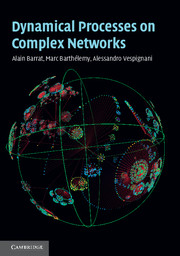Book contents
- Frontmatter
- Contents
- Preface
- Acknowledgements
- List of abbreviations
- 1 Preliminaries: networks and graphs
- 2 Networks and complexity
- 3 Network models
- 4 Introduction to dynamical processes: theory and simulation
- 5 Phase transitions on complex networks
- 6 Resilience and robustness of networks
- 7 Synchronization phenomena in networks
- 8 Walking and searching on networks
- 9 Epidemic spreading in population networks
- 10 Social networks and collective behavior
- 11 Traffic on complex networks
- 12 Networks in biology: from the cell to ecosystems
- 13 Postface: critically examining complex networks science
- Appendix 1 Random graphs
- Appendix 2 Generating functions formalism
- Appendix 3 Percolation in directed networks
- Appendix 4 Laplacian matrix of a graph
- Appendix 5 Return probability and spectral density
- References
- Index
10 - Social networks and collective behavior
Published online by Cambridge University Press: 05 September 2012
- Frontmatter
- Contents
- Preface
- Acknowledgements
- List of abbreviations
- 1 Preliminaries: networks and graphs
- 2 Networks and complexity
- 3 Network models
- 4 Introduction to dynamical processes: theory and simulation
- 5 Phase transitions on complex networks
- 6 Resilience and robustness of networks
- 7 Synchronization phenomena in networks
- 8 Walking and searching on networks
- 9 Epidemic spreading in population networks
- 10 Social networks and collective behavior
- 11 Traffic on complex networks
- 12 Networks in biology: from the cell to ecosystems
- 13 Postface: critically examining complex networks science
- Appendix 1 Random graphs
- Appendix 2 Generating functions formalism
- Appendix 3 Percolation in directed networks
- Appendix 4 Laplacian matrix of a graph
- Appendix 5 Return probability and spectral density
- References
- Index
Summary
The study of collective behavior in social systems has recently witnessed an increasing number of works relying on computational and agent-based models. These models use very simplistic schemes for the micro-processes of social influence and are more interested in the emerging macro-level social behavior. Agent-based models for social phenomena are very similar in spirit to the statistical physics approach. The agents update their internal state through an interaction with their neighbors and the emergent macroscopic behavior of the system is the result of a large number of these interactions.
The behavior of all of these models has been extensively studied for agents located on the nodes of regular lattices or possessing the ability to interact homogeneously with each other. But as described in Chapter 2, interactions between individuals and the structure of social systems can be generally represented by complex networks whose topologies exhibit many non-trivial properties such as small-world, high clustering, and strong heterogeneity of the connectivity pattern. Attention has therefore recently shifted to the study of the effect of more realistic network structures on the dynamical evolution and emergence of social phenomena and organization. In this chapter, we review the results obtained in four prototypical models for social interactions and show the effect of the network topology on the emergence of collective behavior.
- Type
- Chapter
- Information
- Dynamical Processes on Complex Networks , pp. 216 - 241Publisher: Cambridge University PressPrint publication year: 2008



